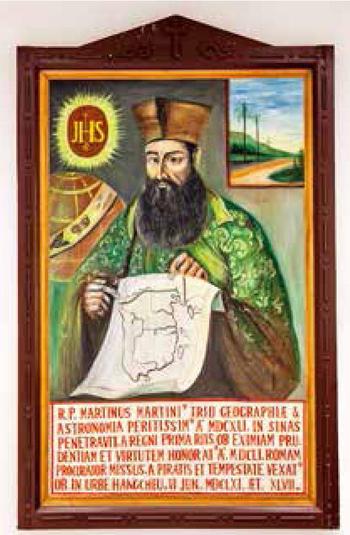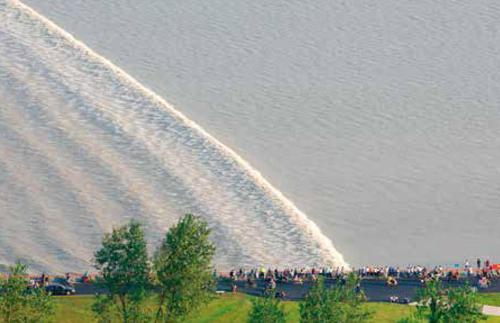卫匡国与杭州的不解情缘
2020-04-20孙昌建
孙昌建



他被西方学界称为“中国地理学之父”
对于钱塘潮,卫匡国这样描述:“潮水实在太有名了,以至那天下午4点左右,包括满清官员在内的所有市民,尤其是陌生人和外地人,都蜂拥而至,要亲眼目睹潮水那惊人的力量。”
马尔蒂尼,一名意大利传教士。
1643年,29岁的他历经千辛万苦终于到达杭州。他以杭州为中心,在江南一带传教,并且开始自学中文。马尔蒂尼给自己起了一个中文名字,姓卫名匡国,有匡护国家之意。
笔者走进位于杭州西溪路549号即老东岳大方井的卫匡国墓园。这个墓园的西侧是大名鼎鼎的杭州中药二厂,以生产青春宝而著称,它的东侧曾是西湖啤酒厂。恰好,它又是古墩路的最南端,就像一個巨大的句号,标点着一段历史的岁月。
首次抵达中国花了4年
卫匡国1614年9月20日出生于意大利特伦托,18岁时他加入耶稣会,后入罗马神学院,先后学习修辞和哲学课程。
1638年,他被派遣前往中国传教。当年12月,他从热那亚启程,由于旅途遭遇风暴,不止一次被迫返回里斯本。因为当时他们乘坐的还是无动力帆船,大海上风向不对就无法航行,而一旦风平浪静也同样无法航行。
1640年,他到达印度果阿以后,又因为缺乏船只,等待了一年多的时间才重新上路,先后换乘了3艘不同的船只,最后于1642年来到中国澳门地区。这一次前往中国的旅行足足花了4年时间,即他从24岁出发,到28岁才到达中国。
1643年,29岁的马尔蒂尼历经千辛万苦终于到达杭州,他入乡随俗取了个中文名字卫匡国,号济泰。这个“济泰”的号正好跟利玛窦的号“西泰”相对应,或许是从中得到某些启发,因为他比利玛窦要晚50年到中国传教。
到达中国后,卫匡国主要在浙江杭州、兰溪、分水、绍兴、金华、宁波一带活动,又在南京、北京、山西、福建、江西、广东等地留下了足迹。从他后来编撰的地图及其他书籍看,他至少游历了中国内地15省()中的六七个省。
他是一个十分“中国化”的传教士。
首先,他能苦学汉语,最后竟能用汉语著书,这在西方世界是第一人;其次他的社交能力超强,三教九流和达官贵人他都能交往,而且有的还成为了好朋友;第三他能言善辩,据说他的演说是极具感染力的。所以他第二次来中国时就有一些信徒跟着来了,那些信徒都是听了他讲的“中国故事”后不远万里、不辞辛苦来到中国的。
逛过西湖看过钱塘潮
1650年下半年卫匡国到达福建,经福州、泉州、漳州、厦门,1651年3月5日他从金门岛的安海乘船去往菲律宾马尼拉。这一路同样走得非常艰辛,有一次光是等船大约就等了一年。
作为一名善实务的学者,他在等待的过程中还是处理了不少的事务,这其中有商业上的事务,更有他个人作品的写作和整理。
而以下卫匡国回国走的这条路线,其实也就是今天我们在讲的“海上丝绸之路”。
据意大利著名学者白佐良()的考证,卫匡国是1652年的5月从印尼雅加达出发前往欧洲的,坐的可能是荷兰军舰。1653年8月底,他经过好望角之后没有走英吉利海峡,而是取道英伦三岛,到达了挪威的卑尔根港,然后再到汉堡、阿姆斯特丹、安特卫普和布鲁塞尔……这个阶段,他一方面在访问汉学家(),二是在联系他的作品的出版事宜,三是筹集资金。
对中西方的交流,卫匡国起到了桥梁和纽带的作用。有人说他是“17世纪撰写中国史的最佳撰稿人”,因为他写作和编撰了4部介绍中国的重要书稿,且都在欧洲出版了。
一是他编写了西方世界里的第一本中文语法书,书名叫《中国文法》,将中文介绍到欧洲。欧洲人第一次见到中国文字时觉得这种文字很奇怪。英国人约翰·韦伯甚至认为中文是上帝在建造巴比伦时所用的语言,是人类最初的共同语言。但此书已经无法找到原初的版本,只有从后人的“抄书”中一窥其貌。
二是他返回欧洲后所写的《鞑靼战记》,描写了明清改朝换代的历史事件,是用拉丁文、英文、意大利文、法文和德文等出版,且在几十年间重版了二十多次,此书被称为“欧洲汉学史上第一部中国现代政治史”,后来欧洲戏剧中不少故事情节的素材,就是取自这一部书。
三是在欧洲出版了《中国上古史》,第一次完整地将中国历史介绍给西方。这部书有不少译名,但讲的都是“上古”,写的是从伏羲、神农到汉朝的历史。据说他还写过下卷,是从东汉到明末清初的,但没有出版,手稿也不知所踪。
四是回欧洲出版了《中国新地图集》(),这是被提及最多、也被认为是他最重要的一部著作。此书是1655年在阿姆斯特丹出版,随后又出版了法文版、德文版和西班牙文版。第一版的序言就长达80页,后面附有17幅地图,除一张中国全图之外,计有北直隶、山西、陕西、山东、河南、四川、湖广、江西、南直隶、浙江、福建、广东、广西、贵州、云南等地地图,以及附录的一张日本地图。该书印刷十分精美,每幅地图都包含有蓝、红、粉、金黄、绿等多种颜色。站在今天的视角看,这图当然有不少错误,但曾有欧洲的专家这样说过:“自卫匡国的《中国新地图集》问世后,从前在公众传播的所有介绍中国的印刷品通通成了废纸。”此书奠定了卫匡国在地理学界的地位,此书为他在西方学界获得了“中国地理学之父”的美称。
这话虽有夸张溢美的成分,但对欧洲学者来说确实是起到振聋发聩的作用。
我们可以看一段他对杭州的“湖”的描述——
这是一个美丽宜人的湖,方圆达四十视距,四周各处都被城墙或山脉环绕,宛若一座迷人的戏院,众多在小小的河床上流淌的溪流注入湖中。环视四周,到处可见山脉、寺观、官殿、庙宇、文化机构、树木、陵寝和美妙的花园。人行道宽阔的路面都由方石铺就,湖面上也有横跨的道路可供行走;同时由于一系列桥梁的存在,游船也可以在桥下通过……
还有对钱塘江潮水的描述,他是这样写的:“每年农历八月十八日,会有一股格外有力的大潮猛力地把河水推回杭州城,这一现象给哲人们提供了丰富的讨论素材。事实上,高潮一年到头都很显著,不过那一天的潮水在力量和强度上超过其他任何一天……”然后他又写道:“潮水实在太有名了,以至那天下午4点左右,包括满清官员在内的所有市民,尤其是陌生人和外地人,都蜂拥而至,要亲眼目睹潮水那惊人的力量。”
從以上的描述来看,卫匡国确实是在杭州的钱塘江边看到过这潮水的,因为即使是今天,即在350多年之后,农历八月十八日的钱塘江潮水,流经杭州萧山及六和塔九溪一带时,也还确实是下午4点到4点半这个时候。
结束传奇一生长眠于杭州
据白佐良先生的考证,1655年的12月19日,卫匡国跟殷铎泽()神甫一起离开罗马前往热那亚,准备再次出发到中国。1956年的1月11日,他带了9名神甫从热那亚出发前往葡萄牙,同行的还有三位去印度的神甫。据记载,这一次他们遇到了法国海盗,虽然也顽强抵抗,但最后还是被监禁了。在这个过程中,卫匡国显示了非凡的勇气和智慧,最终他们都获释并返回热那亚。这使得当初对他有意见的同伴也对他刮目相看了。
后来他们从里斯本出发前往印度的果阿,大约半年之后到达,随后再到印尼的望加锡,1658年的6月17日,他们再从望加锡出发前往中国澳门地区,这一走走了一个月。
这一趟行程显然不是风平浪静的。有资料显示,其他的传教士曾经写信给相关的人,指责卫匡国在航行中独断专行,导致所有人都病倒,并有三位传教士离世。卫匡国本人也病得很重,但是后来教士们又被卫匡国的勇敢所感动,因为在驾驶员都不敢开船的情况下,卫匡国自己在大风大浪中始终手不离舵,最后扛过了风险。这可见卫匡国的威信不是一天两天确立起来的,的确是在经历风浪后的高人一等。因为这个中间有太多的不确定因素,所以一直要到1659年6月11日,卫匡国才回到了杭州。
接下来可能是卫匡国在杭州的蜜月期,因为他得到了浙江巡抚佟国器的支持,所以才有在杭州中山北路造天主教堂的事情。据说在当年教堂建好之后的1660年就有207名中国人受洗,洗礼用的圣水就叫“天水”,这可能也是现在天水桥和天水巷等名称的由来。
但是很不幸,1661年的6月6日,卫匡国因病在杭州病逝,享年47岁。他的病被认为是在航行途中患病而留下的后遗症,而且又得不到正确的治疗。当时他胃疼得非常厉害,又服用了过量的大黄。
卫匡国去世后被安葬在老东岳大方井天主教墓地,这块墓地是由皈依天主教的著名学者杨廷筠之子捐赠给耶稣会的。
20世纪八九十年代,有关方面修复墓园,并将此列入浙江省重点文物保护单位,后来又更名为“卫匡国教士纪念园”。事实上除了卫匡国外,这里还埋葬了诸如金尼阁、郭居静、阳玛诺、徐日升等大名鼎鼎的传教士。现在以卫匡人一人之名而囊括全体,似乎也是因为卫匡国的名气似乎更大一些。
(除署名外,本文摄影:于广明)
Martino Martinis Ties with Hangzhou
By Sun Changjian
Martino Martini, an Italian Jesuit missionary, reached Hangzhou in 1643. He was 29. Hangzhou, then the biggest and most prosperous city in this part of the country, became his base for his missionary work in Jiangnan, the south of the Yangtze River Delta. He called himself 卫匡国, Wei Kuangguo in pinyin, a name that suggests an ambition of supporting and protecting the whole nation.
Martini was born in Trento, in the Bishopric of Trent. After finishing high school studies in Trent in 1631, he entered the Society of Jesus, from where he was sent to study classical letters and philosophy at the Roman College, Rome (1634–37). However his interest was more in astronomy and mathematics which he studied under Athanasius Kircher. In December 1638, he left Genoa, Italy and reached Portugal. The journey wasnt smooth. He had to return to Lisbon several times before winds were friendly enough for the ship to go east. In 1640 he reached Goa, India. He waited there for about a year before there was a ship going out to China. After changing ships three times, he reached Macao in 1642. He was 28. It took him four years to reach Macao.
His missionary work in China largely concentrated in Zhejiang. Based in Hangzhou, he visited Lanxi, Fenshui, Shaoxing, Jinhua, and Ningbo in the province. Beyond the province, he visited Nanjing, Beijing, Shanxi, Fujian, Jiangxi and Guangdong.
Martino Martini spoke and wrote Chinese fluently. He was the first westerner who could write books in Chinese. He was cordial and amicable enough to make friends with people. He was a great speaker.
After six years in Hangzhou, Martino Martini set out on a journey back to Europe. It was an epic journey. It took him another four years. This time, however, he took a different route. Scholars of today say that he took the Silk Road on the Sea back to Europe.
In the second half of 1650, Martino Martini traveled to Fujian, a province south to Zhejiang. His southward journey covered Fuzhou, Quanzhou, Zhangzhou and Xiamen respectively. On March 5, 1651, he set out from Jinmen Island, which is not far from Xiamen, for Manila. He waited for a year in Manila for a ship for the next leg of his long journey back to Europe. In May 1652, he boarded a vessel in Jakarta. In the middle of August 1653 he reached Bergen in Norway. Later he spent time in Amsterdam, Holland and Antwerp, Belgium in 1654 before reaching Rome at the end of the following year. His travels across Europe allowed him to meet those scholars specialized in the studies of China and attempt to publish his works on China and raise funds.
Altogether, Martini published four books on China in Europe. The first book is , the first grammar of Chinese language ever printed and published in the west. The second book is published in Antwerp in 1654. The book describes events including the overthrow of the Ming Dynasty (1368-1644). He wrote the book in Europe and he had lived through the frightful occurrences portrayed in the book. It was translated in many languages and reprinted more than 20 times. It was considered the first history of Chinas contemporary politics in the history of sinology in Europe. His third book published in Europe was . The chronological work covered the earliest age of China. Martini had planned to write the whole Chinese history from earliest age of China up to his time, but only the first part appeared, which covered the earliest times to the Han Dynasty. It was published in Munich in 1658. Whether he had written the whole book is unknown. The fourth book, also his most important work, is , which appeared as part of volume 10 of Joan Blaeus , which was published in 1655 in Amsterdam. Martinis book includes 17 maps and 171 pages of text. It was considered the most complete geographical description of China of that time. He was considered by western scholars as the father of Chinese geology.
In December 1655, Martini left Rome for Genoa. He was going back to China. In January 1656, he and some missionaries set out for Portuguese. The vessel was attacked by pirates and they were imprisoned. After they were released, they set out for Goa, India. Six months later, they reached Goa and then reached Indonesia. In June 1658, they set out for Macao. The journey from Rome to Hangzhou was difficult. It was not until June 11, 1659 that he came back to Hangzhou. With the support of Zhejiang Governor Tong Guoqi, Martini had a three-nave Catholic church built in Hangzhou, located at present-day Zhongshan Road North. The construction was completed in 1660. That year, 207 Chinese disciples were baptized there. The water used in the ceremony was known to local people as “Heavenly Water” or 天水 (Tianshui in pinyin) in Chinese. Tianshui Bridge and Tianshui Lane near the church, the names of two places still in use today, may have come from the church ceremony.
On June 6, 1661, Martini passed away in Hangzhou at the age of 47. It is said that he died of cholera which he had caught on his journey back to Hangzhou and that rhubarb overdosing might have been instrumental in his death. He was buried at a catholic cemetery to the west of the city proper. The plot was donated to the church by the son of Yang Tianyun (1557-1627), a celebrated scholar who converted to Catholicism. The cemetery has been refurbished in the 1980s and designated as a cultural relic under the protection of the provincial government. Though some other important missionaries such as Nicolas Trigault, Lfizaro Catfino, Emmanuel Diaz, and Thomas Pereira lie buried there, the cemetery is known as Missionary Wei Kuangguo Memorial Cemetery.
